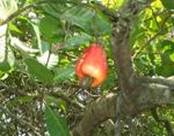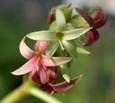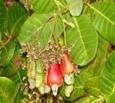| Kingdom | Plantae |
| Unranked | Angiosperm |
| Unranked | Eudicots |
| Order | Sapindales |
| Family | Anacardiaceae |
| Genus | Anacardium |
| Species | A. occidentale |
| Binomial name | Anacardium occidentale |
Other Common Names:
The other common names for the cashew tree are Cajueiro, cashew, cashu, casho, acajuiba, caju, acajou, acaju, acajaiba, alcayoiba, anacarde, anacardier,anacardo, cacajuil, cajou, gajus, jocote maranon, maranon, merey, noix d'acajou, pomme cajou, pomme, jambu, jambu golok, jambu mete, jambu monyet, jambu and terong.
History
The plant is native to northeastern Brazil, where it is called by its Portuguese name Cajú (the fruit) or Cajueiro (the tree). It is now widely grown in tropical climates for its cashew "nuts" and cashew apples. Originally spread from Brazil by the Portuguese, the cashew tree today can be found in all regions with a sufficiently warm and humid climate. The Cashew, Anacardium occidentale L., is a member of the Anacardiaceae family, along with mango, pistachio, poison ivy and poison oak. The family contains 73 genera and about 600 species. Anacardium contains 8 species, native to tropical America, of which the cashew is by far the most important economically.

Description
This pseudo fruit (or "false fruit") is a by-product of the cashew nut industry. The cashew tree, Anacardium occidentale L., is called marañon in most Spanish-speaking countries, but merey in Venezuela; and caju or cajueiro in Portuguese. It is generally bushy, low-branched and spreading; may reach 35 ft (10.6 m) in height and width. Its leaves, mainly in terminal clusters, are oblong-oval or obovate, 4 to 8 in (10-20 cm) long and 2 to 4 in (5-10 cm) wide, and leathery. Yellowish-pink, 5-petalled flowers are borne in 6 to 10-in (15-25 cm) terminal panicles of mixed male, female and bisexual.


Range
Cashew trees are often found growing wild on the drier sandy soils in the central plains of Brazil and are cultivated in many parts of the Amazon rainforest. Eventually it also became dispersed in East Africa and throughout the tropical lowlands of northern South America, Central America and the West Indies. It has been more or less casually planted in all warm regions and a few fruiting specimens are found in experimental stations and private gardens in southern Florida.
Habitat
It is generally seen in tropical, dry and sandy soils. Grows on sterile, very shallow and impervious savanna soils, on which few others trees or crops, will grow, but is less tolerant of saline soil than most coastal plants. Does not tolerate any frost.
Cultivation
Cashew germinates slowly and poorly; several nuts are usually planted to the hole and thinned later. Propagation is generally by seeds, but may be vegetative from grafting, air-layering or inarching. Planting should be done in situ as cashew seedlings do not transplant easily. Recommended spacing is 10 x 10 m, thinned to 20 x 20 m after about 10 years, with maximum planting of 250 trees/ha. Once established, field needs little care. Intercropping may be done the first few years, with cotton, peanut, or yams. Fruits are produced after three years, during which lower branches and suckers are removed. Full production is attained by 10th year and continues to bear until about 30 years old. In dry areas, like Tanzania, flowering occurs in dry season, and fruits mature in 2-3 months. Flowers and fruits in various degrees of development are often present in same panicle. From flowering stage to ripe fruit requires about 3 months. Mature fruit falls to the ground where the 'apple' dries away. In wet weather, they are gathered each day and dried for 1-3 days.
Flowering Season
The flowers are produced in a panicle or corymb up to 26 cm long, each flower small, pale green at first then turning reddish, with five slender, acute petals 7 to 15 mm long generally at the beginning of the dry season. Flowering may occur over several weeks.
Pests and Diseases
Four insects are considered major pests: the white fly (Aleurodicus cocois), a caterpillar (Anthistarcha binoculares), a red beetle (Crimissa sp.), and a thripe (Selenothrips rubrocinctus).High populations of the nematodes Criconemoides, Scutellonema, and Xiphinema are reported around cashew roots. The following are reported disease-causing agents, none of which are considered of economic importance: Aspergillus chevalieri, A. niger, Atelosaccharomyces moachoi, Balladynastrum anacardii, Botryodiplodia theobromae, Cassytha filiformis, Cephaleuros mycoides, Ceratocystis sp., Cercospora anacardii, Colletotrichum capsici, Cytonaema sp., Endomyces anacardii, Fusarium decemcellulare, Gloeosporium sp.and Glomerella cingulata.
Parts Used



The bark, stems, nuts, and resin are the most commonly used parts of the tree for its commercial and medicinal purposes.
Medicinal Applications

• It is used for treating diarrhea, dysentery, all kinds of stomach ulcer and colic pain.
• Cajeurio is also used as an internal and external antiseptic against bacterial infections.
• Infections in the eye and the ear are treated by the extraction from this tree.
• It is used to stop bleeding and heal wounds.
• Cashew leaf or bark tea is still widely used throughout the tropics as an effective diarrhea and colic remedy, considered gentle enough for children.
• The brandy is applied as a liniment to relieve the pain of rheumatism and neuralgia.
• Cashew apple juice, without removal of tannin, is prescribed as a remedy for sore throat and chronic dysentery in Cuba and Brazil. Fresh or distilled, it is a potent diuretic and is said to possess sudorific properties.
• Cajueiro is used in tribal medicine in South America as a contraceptive, snakebite cure, and treatment for parasites and vaginitis.
• It is also prescribed diabetes medication.
• Ayurvedic medicine recommends the fruit for anthelmintic, aphrodisiac, ascites, dysentery, fever, in appetence, leucoderma, piles, tumours, and obstinate ulcers.
• The bark and leaves are used for sore gums and toothache.
• Oily substance from pericarp used for cracks on the feet.
Commercial Applications

• The fruit is used to make highly nutritive snacks and juices, and fruit extracts are now being used in body-care products.
• Cashew fruit is used as a catalyst in the treatment of premature aging of the skin and to remineralize the skin.
• It is also an effective scalp conditioner and tonic and is often used in shampoos, lotions, and scalp creams for the conditioning activity of its proteins and mucilage.
• Its juice is also processed and distilled into liquor or consumed diluted and sugared as a refreshing drink. In Goa, India, the cashew apple is the source of juicy pulp used to prepare fenny, locally popular distilled liquor.
• The wood of a cashew tree is water resistant and is used in constructing boats and ferries.
• Cashew resins are also used in the manufacture of insect repellent and natural insecticides.
• Cashawa gum, used in pharmaceuticals and as substitute for gum arabic.
• Juice turns black on exposure to air and provides an indelible ink.

According to myths, the seeds of cashew nuts were inside the hollow center of its fruit. Similar to the darkness of a womb, the seeds stayed inside the fruit until somebody got them out to be eaten. The myth says the seeds would hear the sounds of the outside world and just wonder about the excitement of what may be going on around them. So one day, the myth says, the cashew nuts could not bear the deprivation any longer.
They wished that things for them would be reversed a bit so that they could be outside their fruit instead of inside. A fairy of the forest heard their wish and granted it. Soon, the myth says, they found themselves outside their fruit. Some unique immigrant traditions are a result of geography. Certain countries whose climate is temperate in December have developed practices that are unrelated to the use of an evergreen tree. Instead, as in the case of Ghana, families decorate either a mango, guava or cashew tree.